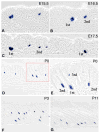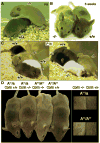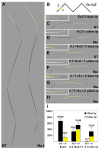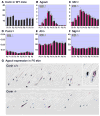The serine protease Corin is a novel modifier of the Agouti pathway
- PMID: 18057101
- PMCID: PMC2186067
- DOI: 10.1242/dev.011031
The serine protease Corin is a novel modifier of the Agouti pathway
Abstract
The hair follicle is a model system for studying epithelial-mesenchymal interactions during organogenesis. Although analysis of the epithelial contribution to these interactions has progressed rapidly, the lack of tools to manipulate gene expression in the mesenchymal component, the dermal papilla, has hampered progress towards understanding the contribution of these cells. In this work, Corin was identified in a screen to detect genes specifically expressed in the dermal papilla. It is expressed in the dermal papilla of all pelage hair follicle types from the earliest stages of their formation, but is not expressed elsewhere in the skin. Mutation of the Corin gene reveals that it is not required for morphogenesis of the hair follicle. However, analysis of the ;dirty blonde' phenotype of these mice reveals that the transmembrane protease encoded by Corin plays a critical role in specifying coat color and acts downstream of agouti gene expression as a suppressor of the agouti pathway.
Figures







References
-
- Barsh G. From Agouti to Pomc--100 years of fat blonde mice. Nat Med. 1999;5:984–5. - PubMed
-
- Barsh G, Gunn T, He L, Schlossman S, Duke-Cohan J. Biochemical and genetic studies of pigment-type switching. Pigment Cell Res. 2000;13(Suppl 8):48–53. - PubMed
-
- Byrne C, Tainsky M, Fuchs E. Programming gene expression in developing epidermis. Development. 1994;120:2369–83. - PubMed
-
- Chai BX, Neubig RR, Millhauser GL, Thompson DA, Jackson PJ, Barsh GS, Dickinson CJ, Li JY, Lai YM, Gantz I. Inverse agonist activity of agouti and agouti-related protein. Peptides. 2003;24:603–9. - PubMed
-
- Challis BG, Coll AP, Yeo GS, Pinnock SB, Dickson SL, Thresher RR, Dixon J, Zahn D, Rochford JJ, White A, et al. Mice lacking pro-opiomelanocortin are sensitive to high-fat feeding but respond normally to the acute anorectic effects of peptide-YY(3-36) Proc Natl Acad Sci U S A. 2004;101:4695–700. - PMC - PubMed
Publication types
MeSH terms
Substances
Grants and funding
LinkOut - more resources
Full Text Sources
Other Literature Sources
Molecular Biology Databases
Miscellaneous

